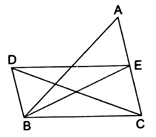In the given figure, BD ‖ CA, E is the midpoint of CA and BD =  CA.
CA.
Prove that ar(∆ABC) = 2×ar(∆DBC).

Given: BD ‖ CA, E is the midpoint of CA and BD =  CA
CA
Consider Δ BCD and Δ DEC
Here,
BD = EC (∵ E is the midpoint of AC that is CE =  CA, BD =
CA, BD =  CA)
CA)
CD = CD (common)
∠BDC = ∠ECD (alternate interior angles, DB||AC)
∴ By SAS congruency
Δ BCD ![]() Δ DEC
Δ DEC
∴ Area (Δ BCD) = Area (Δ DEC) –1
Here,
Area (Δ BCE) = Area (Δ DEC) (triangles on same base CE and between same parallel lines) –2
E is the midpoint of AC, BE is the median of ΔABC
∴ Area (Δ BCE) = Area (Δ ABE) = 1/2 × Area (Δ ABC)
∴ Area (Δ DEC) = 1/2 × Area (Δ ABC) (∵Area (Δ BCE) = Area (Δ DEC))
∴ Area (Δ BCD) = 1/2 × Area (Δ ABC) (∵Area (Δ DEC) = Area (Δ BCD))
19